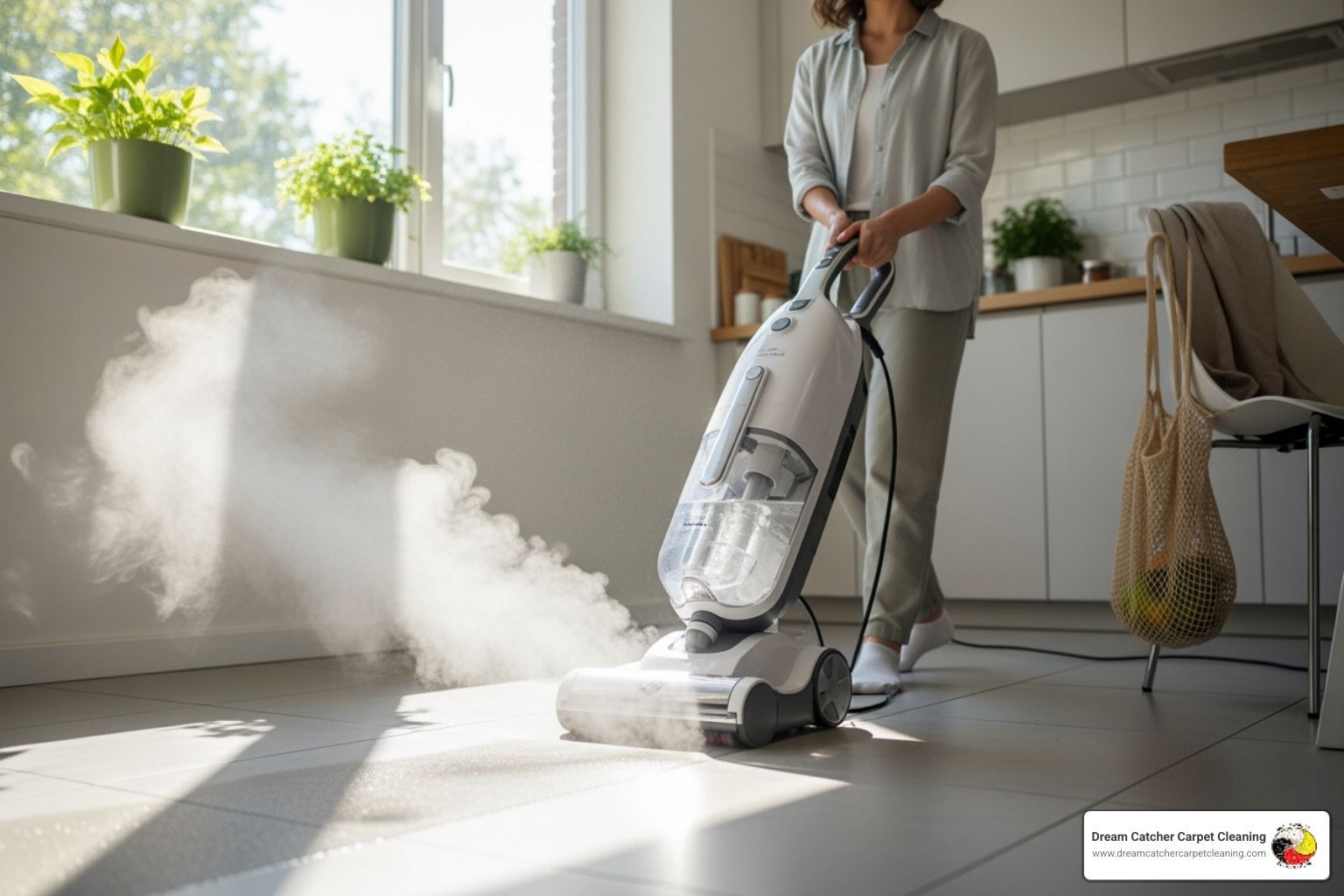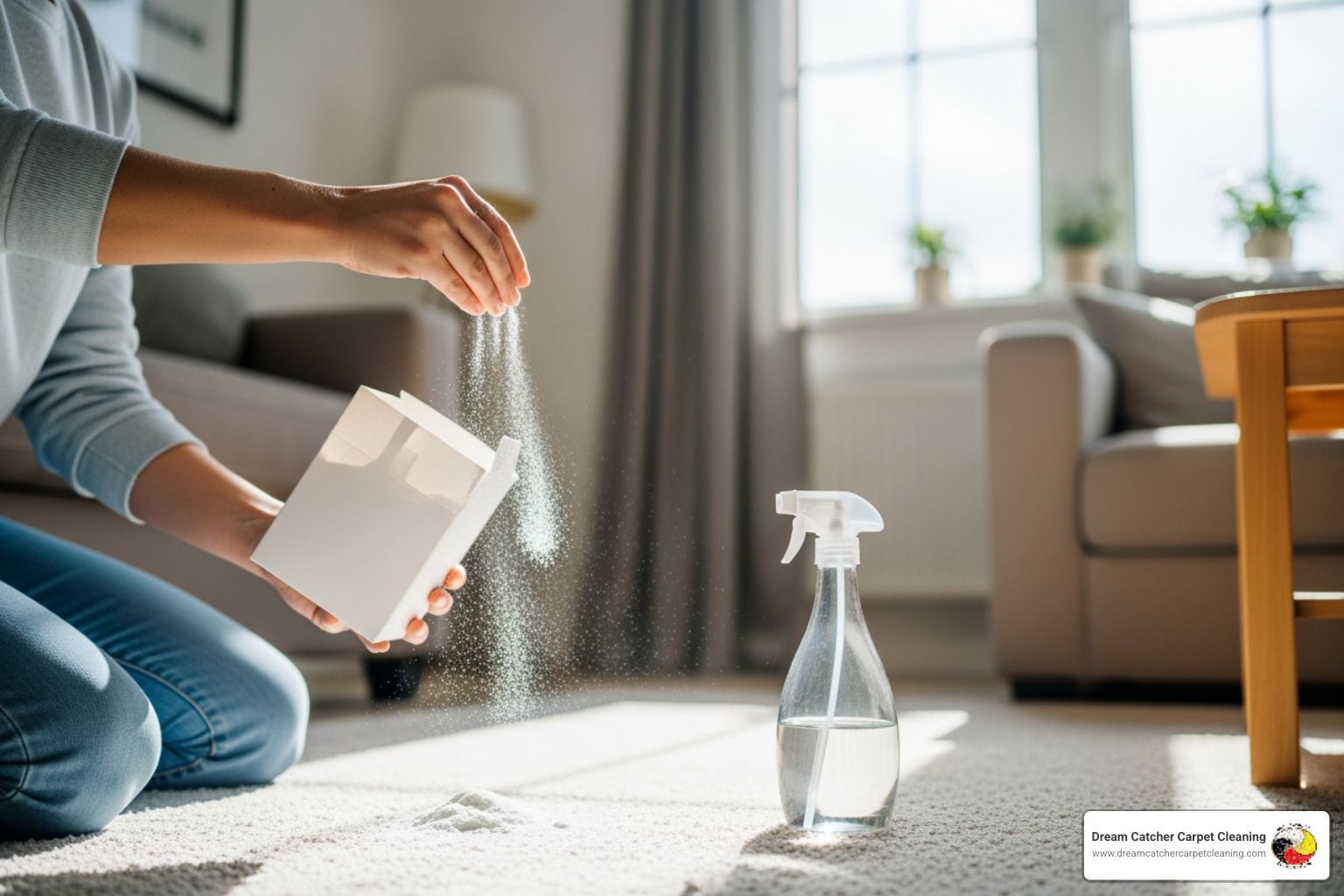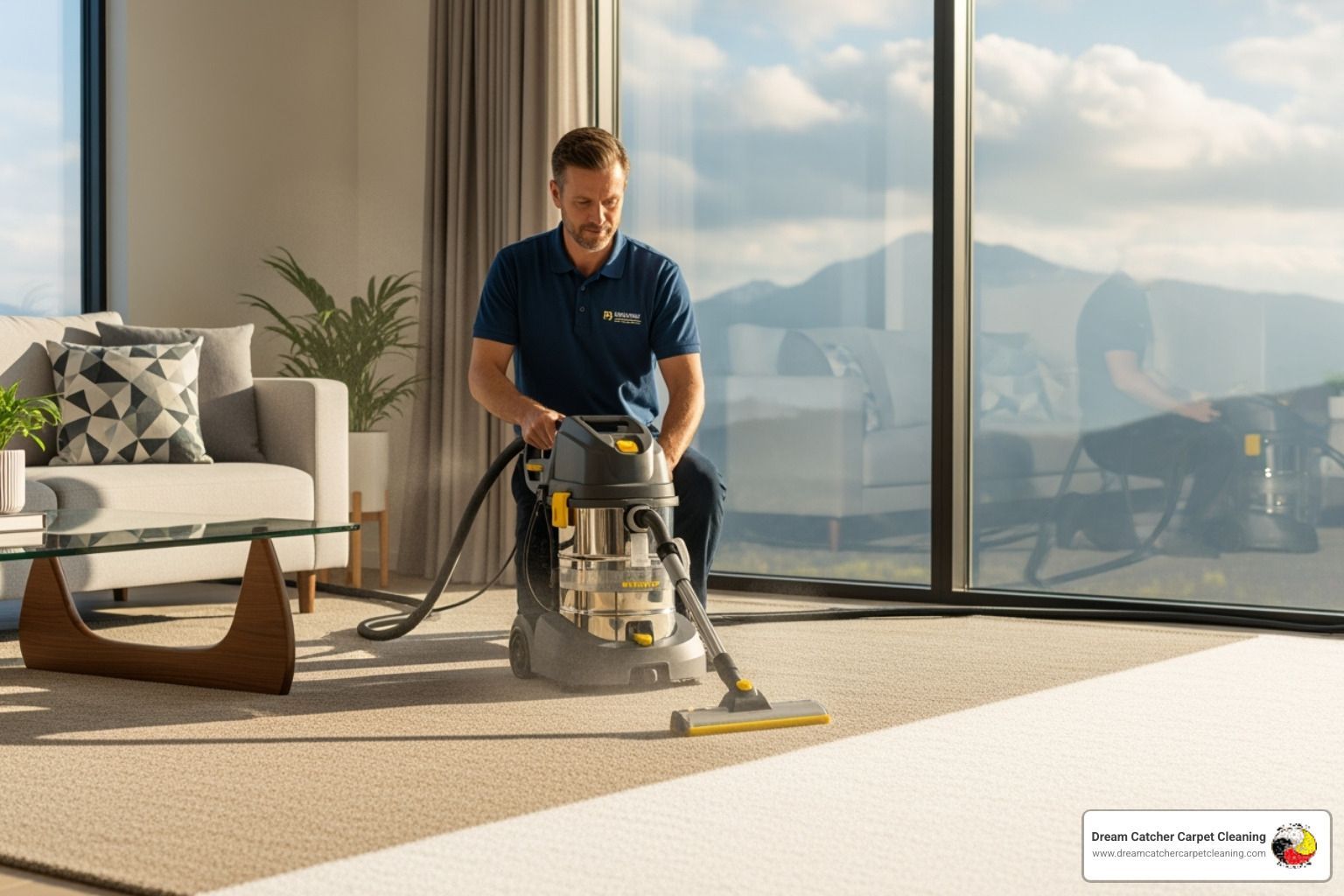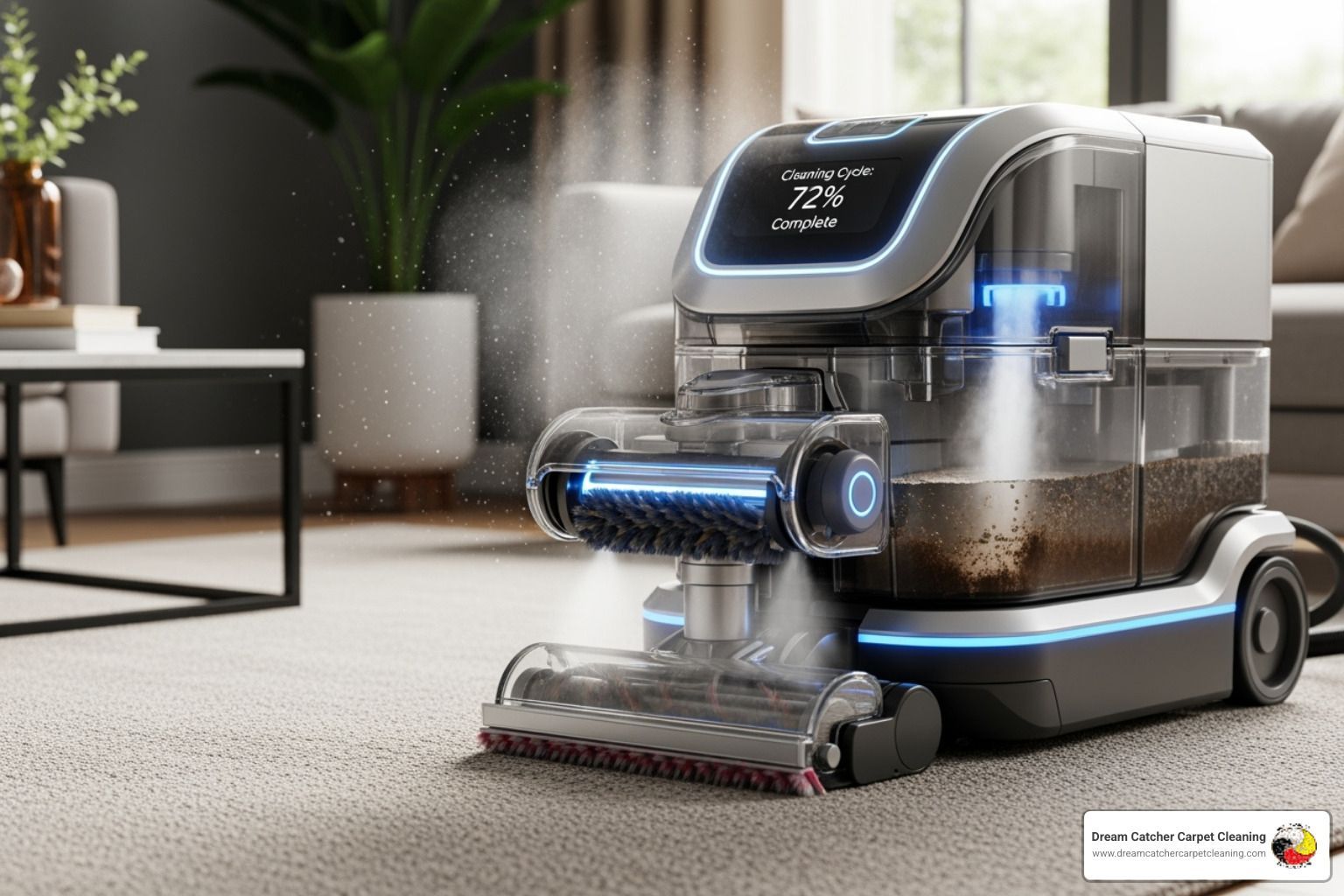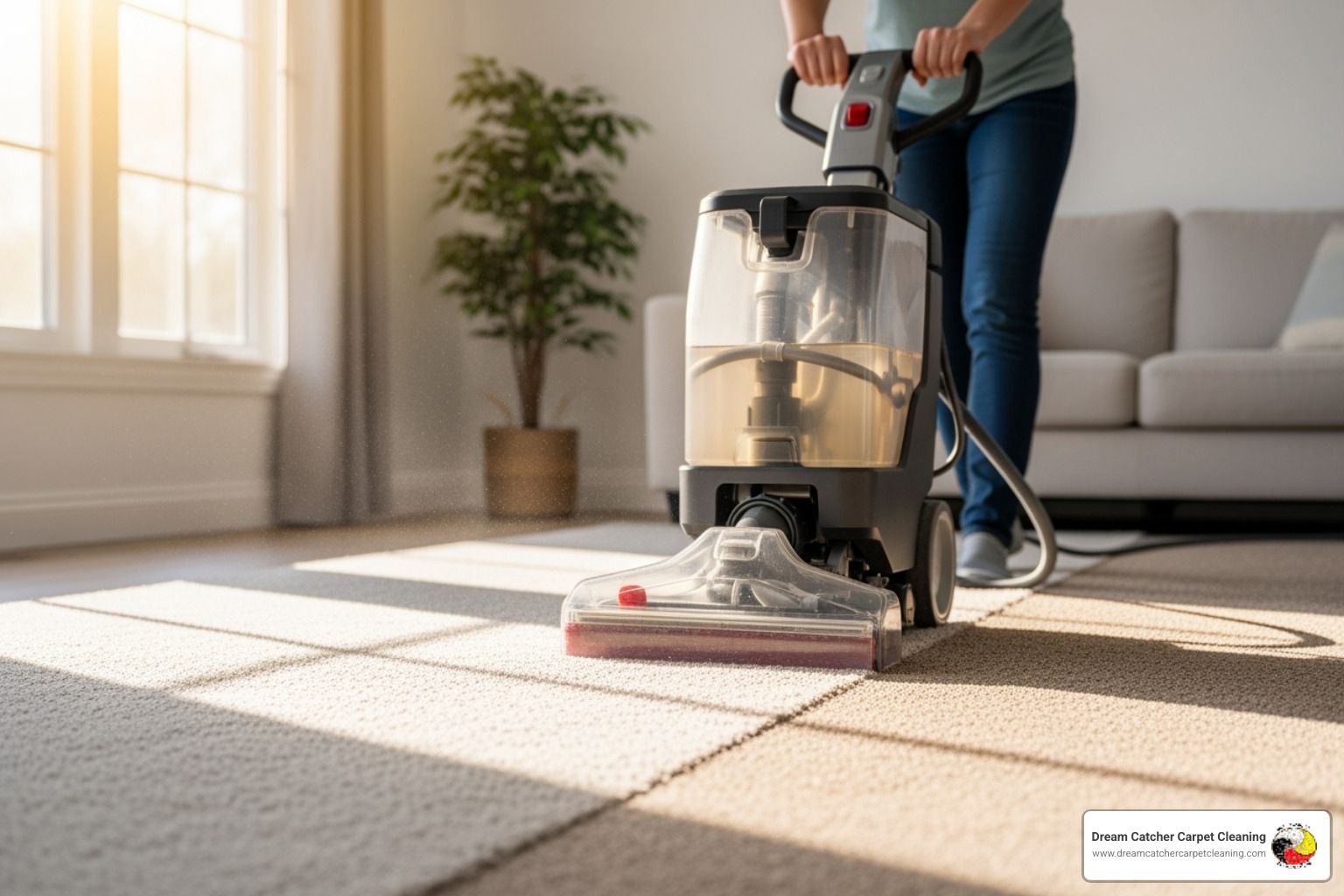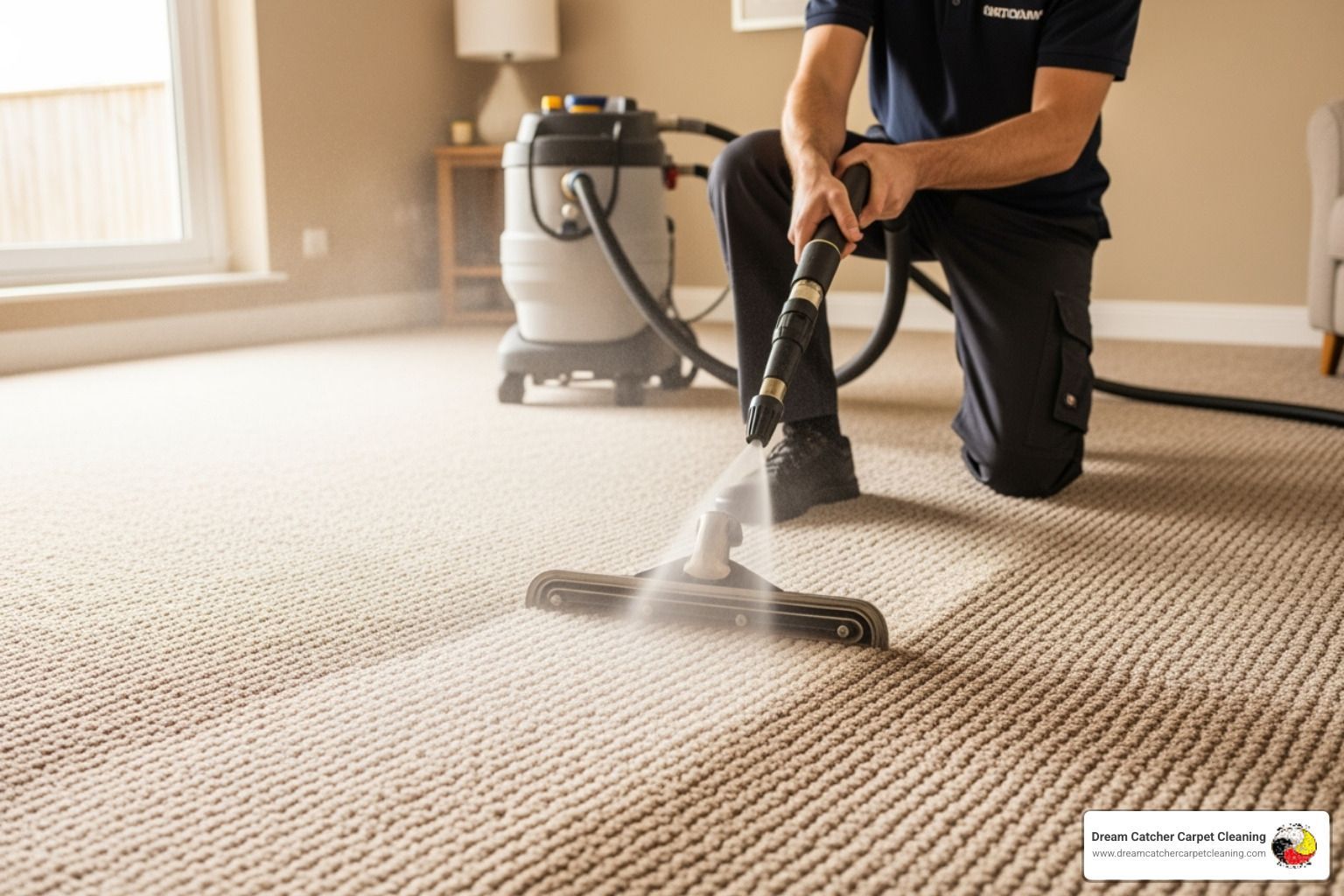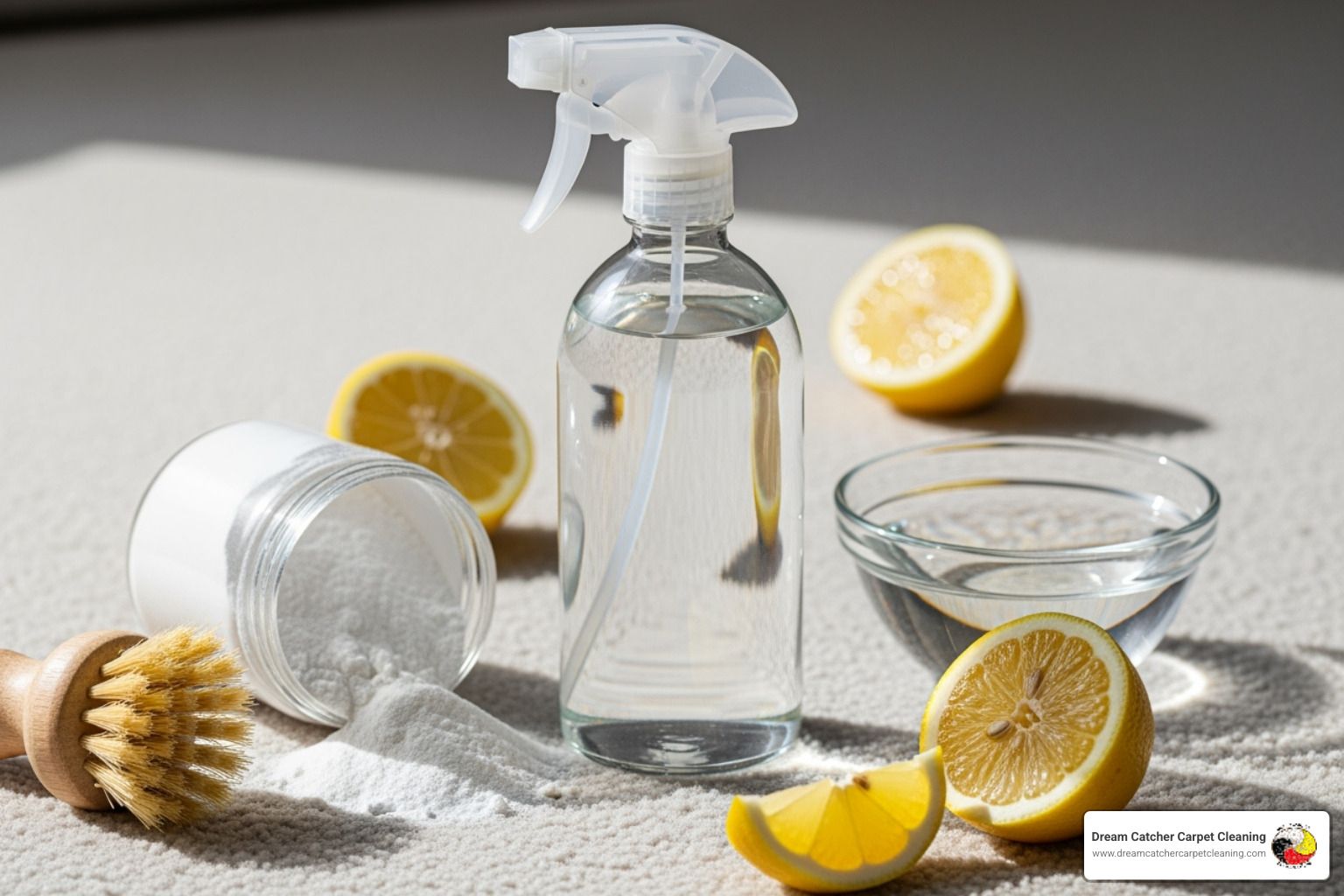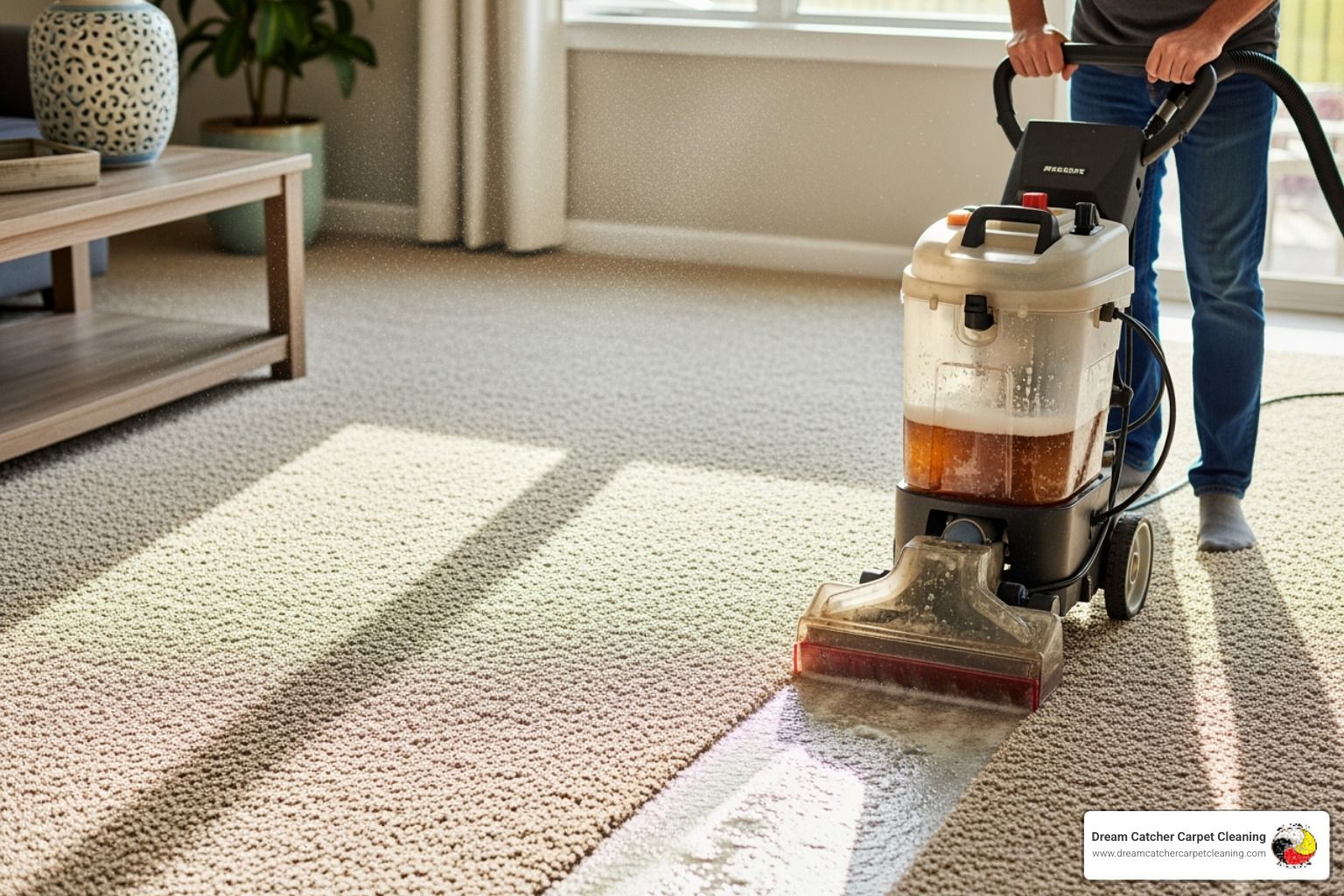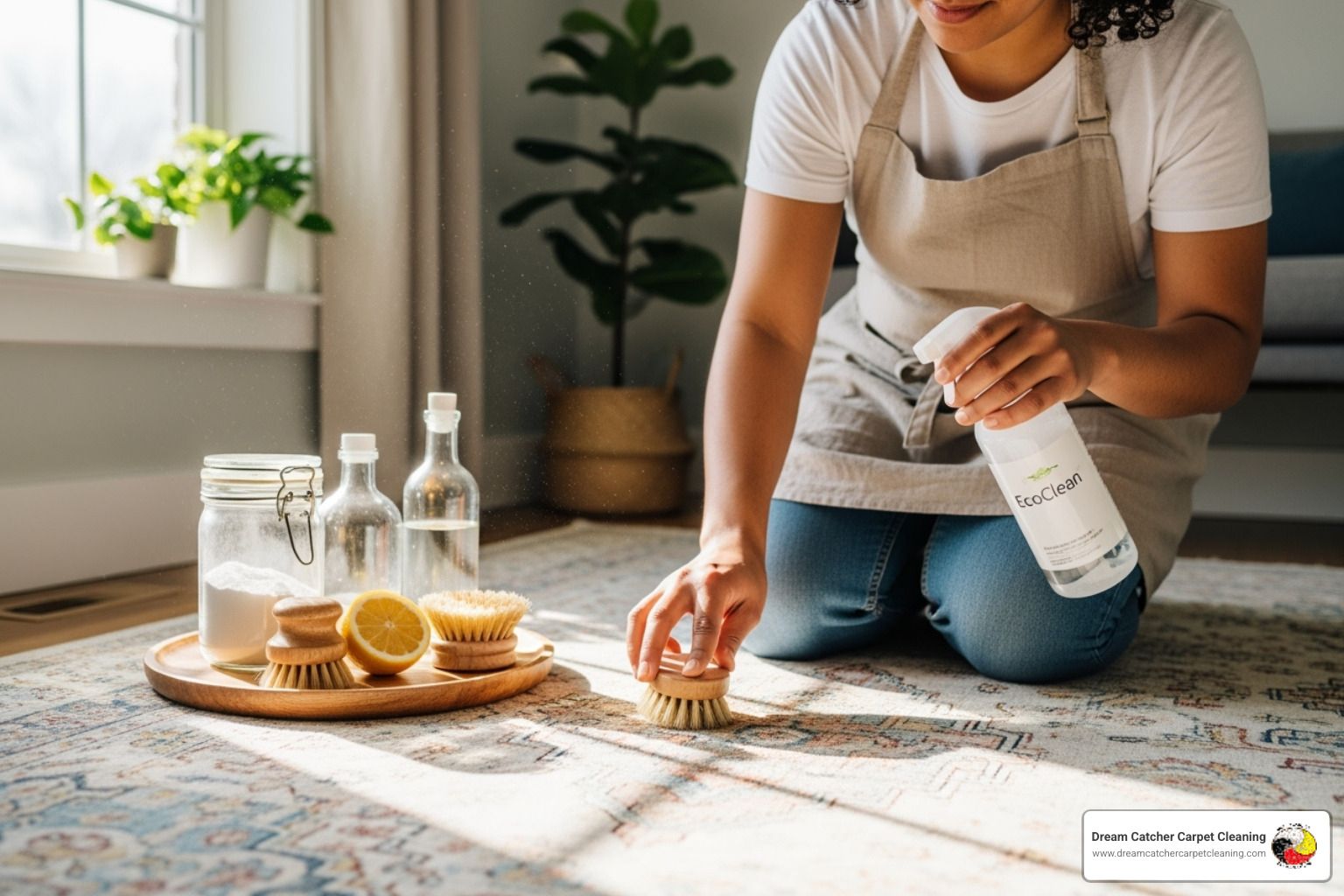Transform Your Tired Chairs Back to Life
Cleaning a chair upholstered doesn't have to be overwhelming, even with pets and busy family life. Here's what you need to know:
Quick Method:
- Check the fabric tag (W = water safe, S = solvent only, WS = both, X = vacuum only)
- Vacuum thoroughly with upholstery attachment
- Spot clean stains with appropriate cleaner for your fabric code
- Deep clean monthly with gentle solution or steam cleaner
- Air dry completely with fans to prevent mold
Whether you have a plush recliner or formal dining room chairs, your upholstered furniture eventually needs attention. Regular cleaning removes dust mites, pet dander, and allergens that build up over time - plus it can extend your furniture's lifespan by years.
The good news? Most upholstery cleaning can be done at home with simple tools and eco-friendly solutions. You just need to understand your fabric type and follow the right steps.
I'm Clarence Smith, owner of Dream Catcher Carpet Cleaning with over 22 years of IICRC-certified experience in cleaning a chair upholstered and other furniture restoration. My Native American values of integrity and fairness guide every cleaning method I recommend, especially for busy families dealing with pet stains and everyday wear.

Decode Your Chair: Fabrics & Cleaning Codes
Think of yourself as a furniture detective - before you start cleaning a chair upholstered, you need to crack the code hidden somewhere on your furniture. Since 1969, manufacturers have been tucking little fabric tags into cushions and seams like secret messages. These tags can save you from accidentally ruining your favorite chair.
Here in North Metro Denver, I've seen every type of upholstery fabric you can imagine. Microfiber acts like a dirt magnet but cleans up beautifully when you know what you're doing. Cotton loves water-based cleaning but can shrink faster than your favorite sweater in hot water. Velvet needs gentle handling to keep that luxurious feel, while leather craves both cleaning and conditioning to stay supple.
Linen brings natural beauty but demands a delicate touch. Wool can handle a lot but will turn into felt if you're too aggressive with water. Then there are performance fabrics - the superheroes of upholstery that resist stains and make life easier for busy families with kids and pets.
The real magic happens when you find that cleaning code tag. W means water-based cleaners only - perfect for mild detergent solutions and steam cleaning, but keep solvents far away. S stands for solvent-based cleaners only - think rubbing alcohol and dry cleaning chemicals, but never water or steam.
WS gives you the best of both worlds - you can use either water or solvent-based cleaners safely. X means hands off - vacuum only, and leave the deep cleaning to professionals like us.
Why Codes Matter
I've walked into homes where well-meaning folks ignored these codes and created disasters. Cotton that shrunk into doll-sized cushions. Beautiful colors that bled into muddy messes. Water stains on fabrics that should never see moisture.
Following manufacturer guidelines prevents about 90% of cleaning mishaps. Even when you have the right code, colorfastness testing protects you from surprise color bleeding. Scientific research on upholstery cleaning codes shows just how critical proper identification is.
If Your Chair Has No Tag
Don't worry if you can't spot a cleaning tag right away. These little labels love to hide under cushions, along back seams, or underneath the chair frame. Sometimes they're tucked so deep you need to feel around like you're searching for loose change.
If there's truly no tag anywhere, try contacting the manufacturer with your model information. When that's not possible, spot testing becomes your best friend. Find a hidden area - maybe behind a cushion or under the chair - and test your chosen cleaner on a small spot. Wait a full day to see if anything changes color, shrinks, or looks different before proceeding with cleaning a chair upholstered.
Gather Your Gear: Tools & Safe Solutions
Getting ready for cleaning a chair upholstered is like preparing for any home project - having the right tools makes all the difference between success and frustration. After 22 years in the business, I've learned that you don't need expensive equipment to get professional results.
Your vacuum with an upholstery brush attachment is your best friend here. The brush loosens embedded dirt while the suction pulls it away. Don't forget the crevice tool - it's perfect for getting into those tight spaces where pet hair loves to hide.
You'll also want a soft-bristled brush on hand (an old toothbrush works beautifully for spot cleaning). Microfiber cloths are essential - grab at least six to eight clean ones because you'll go through them quickly. Having enough means you're not spreading dirt around.
For mixing and applying solutions, simple spray bottles and a bucket are all you need. Fans become crucial during the drying process, and if you have a HEPA filter vacuum, even better - it captures up to 96.5% of allergens that regular vacuums miss.
The real magic happens with your cleaning solutions, and here's where we keep things simple and safe. Baking soda works wonders for deodorizing and provides gentle scrubbing power. White vinegar acts as a natural deodorizer and mild acid that breaks down many stains. A few drops of mild dish soap creates the perfect gentle surfactant for most fabrics.
For tougher challenges, rubbing alcohol tackles ink stains like nothing else, while 3% hydrogen peroxide handles organic stains and provides gentle disinfecting power. The average home collects up to 40 pounds of dirt and allergens each year, and much of it ends up in your furniture.
Want to dive deeper into professional techniques? Check out our upholstery cleaning tricks you never knew about for methods that really work.
DIY vs. Store-Bought Cleaners
Here's something that might surprise you - those expensive commercial cleaners often aren't any better than what's already in your kitchen cabinet. We're big believers in eco-friendly cleaning agents, especially when kids and pets are involved.
Homemade solutions using household items are often just as effective and much safer for your family. Mix one cup of warm water with a quarter cup of white vinegar and a squirt of dish soap for an excellent general cleaner. For stubborn stains, try two cups of water mixed with two cups of white vinegar.
Baking soda makes an excellent deodorizer when you mix about 150 grams with five or six drops of your favorite essential oil. Just sprinkle it on, let it sit, then vacuum it up.
That said, enzyme cleaners from the store really shine when dealing with pet accidents and biological odors. They actually break down the proteins that cause smells rather than just masking them. For fabrics with an S-code, you might need solvent-based cleaners that you simply can't make at home safely.
The key is matching your cleaner to your fabric code and the type of stain you're fighting. Start gentle and work your way up - you can always use something stronger, but you can't undo damage from harsh chemicals.
Cleaning a Chair Upholstered: Step-by-Step
Now comes the rewarding part - actually cleaning a chair upholstered and watching it transform back to its former glory. Think of this as a three-level approach: your regular maintenance routine, emergency spot treatments, and those deep seasonal cleanings that really make a difference.
The beauty of having a systematic approach is that you'll catch problems early, before they become permanent stains or odors. Plus, your family gets to enjoy cleaner air and a fresher-smelling home.
Routine Vacuuming for Cleaning a Chair Upholstered
Your vacuum is honestly your best friend when it comes to upholstery care. Weekly vacuuming for daily-use chairs (or monthly for occasional-use furniture) removes the dirt and debris that acts like sandpaper on fabric fibers over time.
Here's the technique that makes all the difference: remove all cushions first and vacuum both sides thoroughly. You'll be amazed at what's hiding underneath - everything from pet hair to lost cheerios to dust bunnies that have been camping out for months.
Use your upholstery attachment for all fabric surfaces, moving in slow, overlapping strokes. The key is patience - quick passes just shuffle dirt around instead of actually removing it. Switch to the crevice tool for seams, corners, and those tight spaces where crumbs love to hide.
Before your final pass, brush the fabric lightly with a soft-bristled brush to lift embedded dirt to the surface. This simple step can double the effectiveness of your vacuuming. Don't forget to flip those cushions regularly too - it helps them wear evenly and look better longer.
Spot Cleaning a Chair Upholstered
Life happens, and when it does, quick action saves the day. Whether it's coffee from your morning rush or a juice box explosion, the golden rule is simple: blot, never rub. Rubbing just pushes stains deeper into the fibers.
Start with universal first aid for any spill. Scrape up solids with a credit card edge, then blot liquids with clean paper towels. Work from the outside of the stain toward the center - this prevents it from spreading. Change towels frequently because using dirty ones just spreads the mess around.
For specific stains, your approach matters. Coffee and tea respond well to warm water mixed with a drop of dish soap. Wine stains often surrender to 3% hydrogen peroxide, but test it first in a hidden spot. Ink marks usually disappear with rubbing alcohol applied with a cotton swab.
Grease stains need a different strategy - make a paste with baking soda and water, let it sit for 15-20 minutes to absorb the oil, then vacuum it up. For pet accidents, enzyme cleaners are your best bet because they actually break down the organic compounds that cause odors.
Our go-to vinegar solution works wonders on most water-safe fabrics: equal parts white vinegar and water in a spray bottle. Spray lightly, then dab with a microfiber cloth. The vinegar naturally deodorizes while cleaning.
Monthly & Seasonal Deep Clean
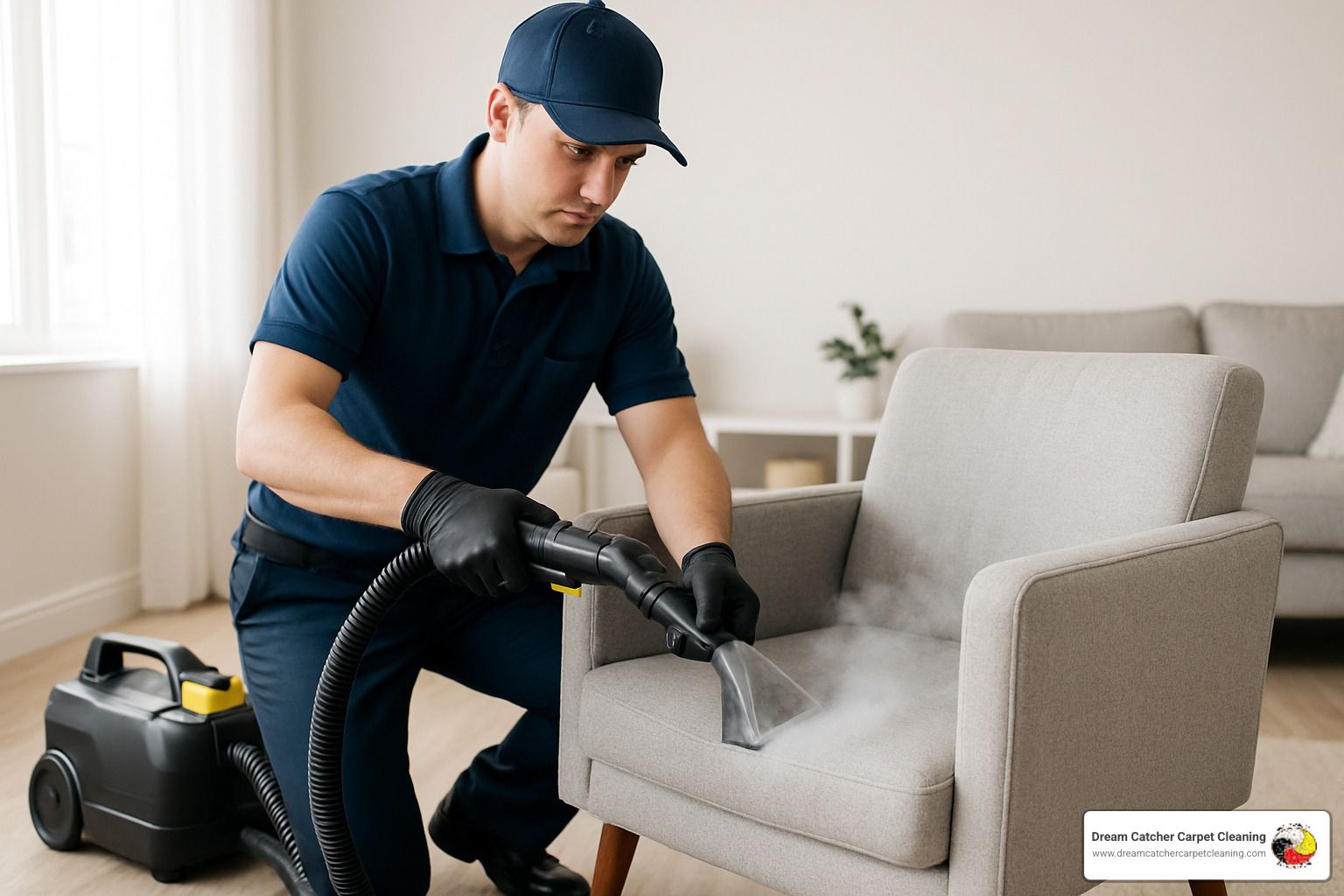
Deep cleaning transforms tired-looking furniture back to its original beauty. Plan for this seasonally, or more often if you have pets or heavy use. This is where you really tackle embedded dirt, allergens, and odors that regular vacuuming can't reach.
For W and WS code fabrics, start with thorough vacuuming, then mix one teaspoon of mild detergent per gallon of warm water. Always test in an inconspicuous area first - we can't stress this enough. Apply the solution with a barely damp microfiber cloth, working in small sections so nothing stays wet too long.
The secret is in the rinse step that many people skip. Use a clean, damp cloth to remove soap residue, then extract moisture with dry towels. Soap left behind attracts dirt faster, so this step actually keeps your chair cleaner longer.
Steam cleaning can be incredibly effective if your fabric allows it. Use low heat settings and keep the steamer moving to avoid over-wetting. Research shows that hot-water extraction can remove up to 94% of common household allergens while killing bacteria naturally.
For S-code fabrics, stick with dry cleaning solvents or leave it to the professionals. Water can cause permanent damage to these materials, and it's not worth the risk.
When dealing with persistent odors, enzyme deodorizers work by actually breaking down the smell-causing compounds rather than just masking them. This is especially important for pet odors that can resurface if not properly treated.
For comprehensive professional service that uses advanced hot-water extraction methods, explore our upholstery cleaning services. Sometimes calling in the experts is the smartest investment you can make in your furniture's longevity.
Dry It Right & Shield Against Future Messes
The cleaning job isn't done until your chair is completely dry. This might be the most important step that people skip - and it's where things can go terribly wrong. Proper drying prevents mold, mildew, and those stubborn water stains that can ruin all your hard work.
Most chairs need 2-6 hours of drying time, depending on how much moisture you used and what type of fabric you're working with. Thick cushions and dense fabrics like wool take longer, while microfiber dries relatively quickly.
Set up your drying station like a pro: Position fans to blow air across the chair from multiple angles. If the weather's nice, crack open some windows for cross-ventilation - fresh air is your friend here. But keep your chair away from direct sunlight, which can fade colors faster than you'd expect.
Here's what NOT to do: Don't aim a hair dryer at wet upholstery or push it up against a heater. High heat can shrink fabrics, set stains permanently, or even cause cracking in leather. Let the air do the work.
Watch for warning signs that something's going wrong. If you smell anything musty after a few hours, or if the fabric still feels damp after 8 hours, you need more airflow. Dark spots appearing anywhere mean potential mold growth - act fast with more fans and possibly a dehumidifier.
In our humid Colorado summers, we often recommend running a dehumidifier while cleaning a chair upholstered to speed the process and prevent moisture problems.
Odor-Control Hacks
Sometimes your chair needs more than just cleaning - it needs a complete odor makeover. Whether it's pet smells, cooking odors, or just that mysterious "old furniture" scent, we've got natural solutions that actually work.
The overnight baking soda trick is pure magic. Sprinkle baking soda generously over the entire chair, add a few drops of your favorite essential oil (lavender and tea tree are great choices), and let it sit overnight. The baking soda absorbs odors while you sleep, and you just vacuum it up in the morning.
Here's a surprising one: vodka in a spray bottle can neutralize odors without leaving any scent behind. The alcohol evaporates quickly, taking other smells with it. Yes, it sounds weird, but it works - especially for smoke odors.
White vinegar spray is another powerhouse. Mix equal parts water and white vinegar, mist lightly over the fabric, and let it air dry. Don't worry about the vinegar smell - it disappears as it dries, taking other odors along for the ride.
Preventive Maintenance Schedule
The secret to keeping your chairs looking great isn't just knowing how to clean them - it's staying ahead of the mess. Think of it like brushing your teeth: a little effort regularly beats a major intervention later.
Weekly maintenance should include light vacuuming with your upholstery brush and immediate attention to any spills. Don't let that coffee ring sit until the weekend - blot it now, deal with it properly later if needed.
Monthly deep care means pulling out those cushions for thorough vacuuming, rotating reversible cushions to distribute wear, and checking for any developing problem areas. This is also when you might need to reapply fabric protector spray if you notice water isn't beading up like it used to.
Every three months, do a complete spot-check for stains you might have missed and give extra attention to high-wear areas like armrests. If you have valuable or antique pieces, this is a good time to assess whether they need professional attention.
Twice a year, commit to complete deep cleaning of all your upholstered furniture. This is also when you should reapply fabric protection and consider professional cleaning for pieces that get heavy use.
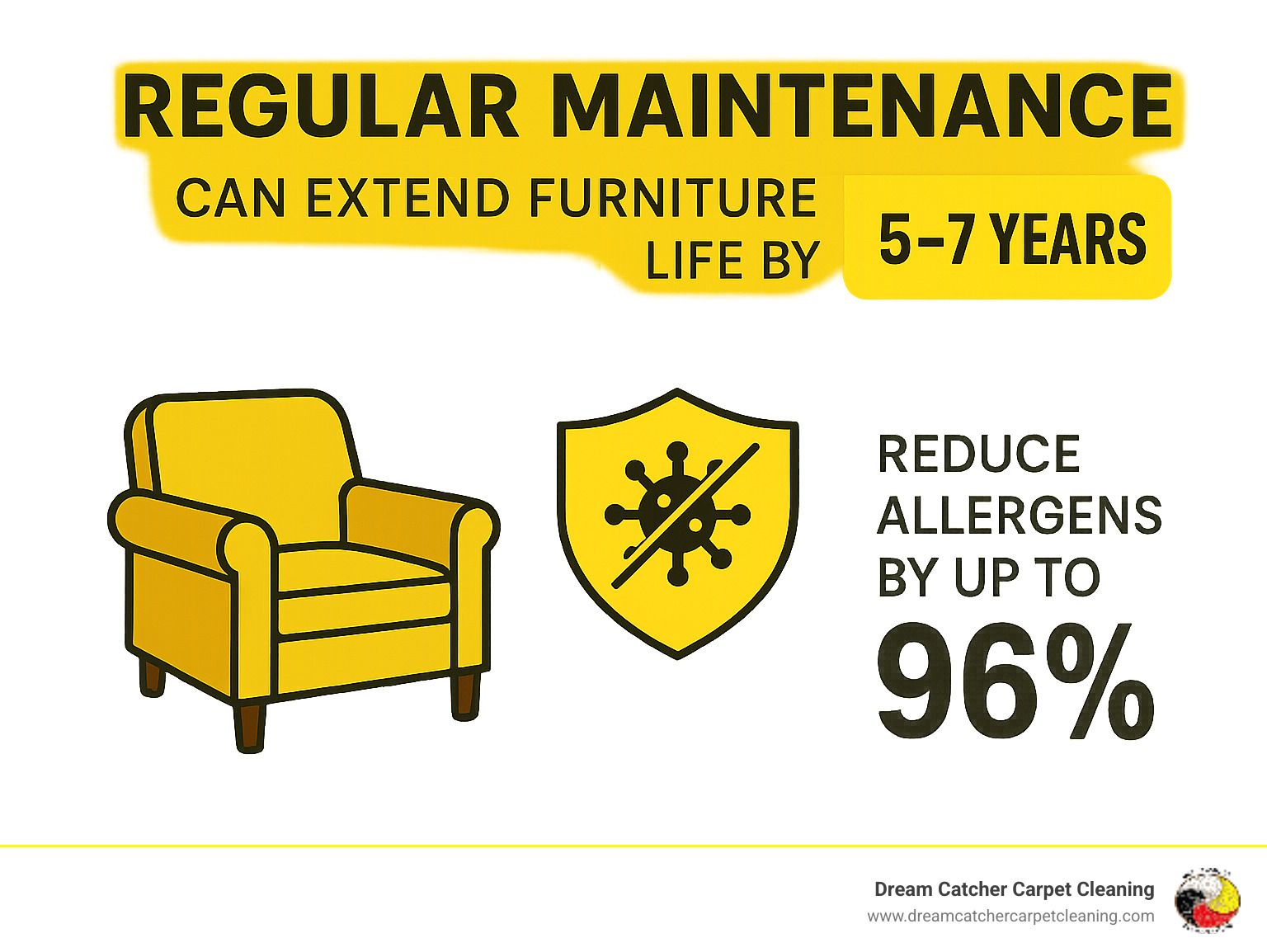
Smart protection strategies make all the difference. Apply fabric protector spray after every deep cleaning - products like Scotchgard create an invisible barrier that gives you time to clean up spills before they become stains.
Use removable slipcovers during movie nights or messy activities, and keep dedicated pet throws on spots where your furry friends like to curl up.
Rotate your cushions regularly - even monthly if they get daily use. This distributes wear patterns and prevents that sad, lopsided look that screams "this is where Dad watches TV every night."
The golden rule? Address spills immediately. Waiting even an hour can turn a simple cleanup into a permanent reminder of that time you spilled red wine during the big game.
Conclusion
There's something deeply satisfying about changing a tired, stained chair back into the beautiful piece it once was. Cleaning a chair upholstered properly isn't just about appearances - it's about creating a healthier home for your family and protecting an investment that should last for decades.
The secret isn't complicated: understand your fabric codes, use the right tools, and stick to a regular cleaning schedule. When you remove those dust mites, pet dander, and everyday allergens through consistent care, you're not just maintaining furniture - you're improving your family's indoor air quality.
I've watched countless homeowners across the North Metro Denver area find how routine maintenance can completely transform their living spaces. A monthly vacuum removes up to 96.5% of allergens, while proper deep cleaning every six months keeps fabrics looking fresh and extends their lifespan by years.
Sometimes, though, life gets busy. Maybe you're dealing with a particularly stubborn pet accident, or you have delicate antique pieces that need expert attention. That's when professional help makes sense.
At Dream Catcher Carpet Cleaning, we understand that your upholstered furniture holds memories - from family movie nights to holiday gatherings. Our COVID-safe cleaning services use advanced hot-water extraction and eco-friendly solutions to restore your chairs safely, without harsh chemicals that could affect your family or pets.
Your chairs have been there for you through countless moments - supporting you during late-night feedings, providing comfort during illness, hosting friends during celebrations. They deserve care that honors that relationship.
Start simple: grab your vacuum and give your favorite chair some attention today. Notice how much better it looks and feels after just that basic step. Your furniture - and your family's health - will thank you for the effort.
Ready to take the next step? Whether you tackle the job yourself or call in professional help, the important thing is taking action. Those chairs aren't going to clean themselves, but with the right approach, they'll reward your efforts with years of continued comfort and beauty.

